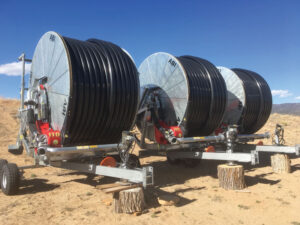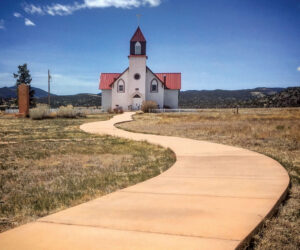By John Mattingly
Songwriter Leonard Cohen’s “Everybody Knows” should include the dicta: we need the rain like the rain needs the sky.
The Sangre de Christo mountains are as bare as most of us have ever seen them in mid-May. On average, peak runoff from the Sangres is the last two weeks of May, and as spring becomes summer there are lingering snow patterns in the canyons, usually in July, that indicate when the snow is about half gone. The half-gone patterns were seen in early March this year, and the traces of snow near Sangre summits are no more than sublimating ghosts. The runoff this year will be a walk off, at best.
Following a dry year in 2019, the reach of the dry times is visible in the trees dying in the Valley floor where the sub-moisture has declined below the root zone, and in the advance of dying evergreens in the high elevations, and in the dust that lingers in the air all night, and from the blistering winds that sear stems off sprouted crops, and with irrigator blisters and dry-cracked hands.
There was a time in the Valley, in the late 1980s and early 1990s when, just as Eskimos had many different kinds of snow, the Valley had enough moisture that there were species of rains: goose-drownders, turtle turners, frog stranglers, ant floaters, duck twirlers and the bull dropper. I have seen only one bull dropper in the Valley on an occasion when four bulls put their heads together in the middle of a pasture in an effort to shield themselves from the downpour, only to be driven to ground where they rested their foreheads together.
It was common in the wet times for monsoon rains to drop an inch an hour in thunderstorms that started like clockwork on the Fourth of July, and you could depend on an Albuquerque low in early August to sit on the Valley for three or four days and drizzle in a good two or three inches.
Too, in the wet times, there were occasional monster storms. Ralph Mitchell, who was a true old timer from Moffat, told me that in the ’40s and ‘50s there were often big snow storms in early June, and one case of six feet at the head of Cotton Creek on June 1. During very wet years, it was possible to canoe from Road AA to the Sand Dunes with only a couple of portages.
Hailstorms used to come with regularity, some leaving eight to ten inches of ice. There were times when snowplows had to be called out to move the hail off the highway and the ice froze some of the potato crop in the ground. You know you are desperate for moisture when you concede that if it must come as hail, so be it. For the last few years, when it rains a tenth of an inch, it almost feels like a cloudburst.
In the deep dry times, it occasionally starts to rain at night. The pelting on the roof sounds promising until a gust of wind comes along, abruptly ceasing the rain. We rush outside, just to smell the moisture in the plants that breathed it in before the wind took it away.
Then there are the big, black-and-blue drought clouds, the ones that look ripe with moisture, but do little more than provide passing shade, for which we bend over backwards to praise in the dry times. When showers or downpours appear in the offing, or tremendous lightning storms go off to the east at night, our suspicion is confirmed that other places will always get more rain that we do.
There clearly are cycles of wet and dry times, going back at least a couple hundred years, with a periodicity of twenty to thirty years. I recall farming through the dry times of the late 1970s and early 2000s, while hearing a lot of stories from older farmers who had made it through the great droughts of the early 1950s and mid-1930s. There are also cycles within the cycles that correlate to sunspot activity on roughly eleven year cycles.
Then there are the Milankovitch Constants that relate to the Earth’s tilt, orbit, and procession. Over roughly 41,000 year cycles, the tilt of earth’s axis varies from 21.5 degrees to 24.5 degrees. Currently Earth is at a 23.5 degree tilt, which slants toward colder times for the middle latitudes. Every 125,000 years (or so), Earth’s orbit is influenced by Jupiter and becomes more elliptical. At the outer reach of the ellipse, Earth is further from the sun and solar radiation is reduced by about a quarter.
Given the current level of carbon dioxide in Earth’s atmosphere, there probably should be palm trees on the North Pole, were it not for Earth presently being in a convergence of Milankovitch Constants that have the planet in a deep cooling period, which may indicate that the human activity driving global warming has actually saved human activity from dealing with something approaching Snowball Earth.
Even though there have been remarkable advances in weather and climate research and modeling, and even though we know a lot more about what we don’t know, from the point of view of people who work mostly outside—of which agriculture is one, but certainly not the only—weather and climate interact in a punctuated disequilibrium, seemingly calibrated to exploit every weaknesses in human reasoning, from confirmation bias to anecdote worship to cross-threading correlation with causation.
Ilya Prigogine, the mathematician and chaos theorist offered proof that every particle of the universe is in a constant state of disequilibrium: “Nature is never in balance.” Add to that Bill Brower’s narrative that “Earth is a dangerous place” and one might look for hope in the final thoughts of Princeton physicist John Archibald Wheeler, who studied astrophysics in relation to the human mind, “We are living in a participatory conscious universe in which we are all embedded as co-creators.”
If perspective and magical physics fail us, we can look at holes in the sky and howl.
John Mattingly cultivates prose, among other things, and was most recently seen near Moffat.
A Farmer Far Afield is sponsored by Cheryl Brown-Kovacic and Larry Kovacic.


